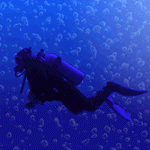The Somnoplasty procedure for obstructive sleep
The Somnoplasty procedure for obstructive sleep
I have to pass this information around, because my doctor has me schedule for this Nov. 8th, 2007
Somnoplasty is a new, minimally invasive treatment for snoring, chronic nasal congestion, and sleep apnea that is performed in the comfort of our patient care office. Somnoplasty uses low-power, low-temperature radiofrequency energy to treat a well-defined area in the patient's soft palate (for snoring), nasal turbinates (for nasal congestion), or the base of the tongue (for sleep apnea).
The radiofrequency energy is delivered just below the surface of the tissue. This creates an area of "coagulation" in the treated tissue. This treated and "coagulated" tissue sloughs-off during the three to six week period following Somnoplasty thereby naturally reducing the volume of the tissue that leads to snoring.
The Somnoplasty procedure for obstructive sleep shrinks the soft tissue in the upper airway including the base of tongue, which is the source of obstruction.
Has anyone had this done, and what improvements can I expect as results………?????
Rich03079
http://www.yalemedicalgroup.org/somnopl ... somno.html
Somnoplasty is a new, minimally invasive treatment for snoring, chronic nasal congestion, and sleep apnea that is performed in the comfort of our patient care office. Somnoplasty uses low-power, low-temperature radiofrequency energy to treat a well-defined area in the patient's soft palate (for snoring), nasal turbinates (for nasal congestion), or the base of the tongue (for sleep apnea).
The radiofrequency energy is delivered just below the surface of the tissue. This creates an area of "coagulation" in the treated tissue. This treated and "coagulated" tissue sloughs-off during the three to six week period following Somnoplasty thereby naturally reducing the volume of the tissue that leads to snoring.
The Somnoplasty procedure for obstructive sleep shrinks the soft tissue in the upper airway including the base of tongue, which is the source of obstruction.
Has anyone had this done, and what improvements can I expect as results………?????
Rich03079
http://www.yalemedicalgroup.org/somnopl ... somno.html
- DreamDiver
- Posts: 3082
- Joined: Thu Oct 04, 2007 11:19 am
Long Term Studies?
I'd be curious about the long-term effects of such treatment.
Is it still experimental? It sounds promising.
I'll PM you some peer-reviewed medicalese.
Is it still experimental? It sounds promising.
I'll PM you some peer-reviewed medicalese.
_________________
| Mask: ResMed AirFit™ F20 Mask with Headgear + 2 Replacement Cushions |
| Additional Comments: Pressure: APAP 10.4 | 11.8 | Also Quattro FX FF, Simplus FF |
Put a little less gingerly, somnoplasty cooks pea-sized chunks of tissue under the skin. These cooked spots are then absorbed by the body leaving a reduced volume which makes the palette, tongue, whatever shrink a bit.
It isn't new, I looked at it years ago. My ENT tells me that long term studies haven't shown somnoplasty (genericly refered to as RF ablation) to be very effective in treating OSA.
It isn't new, I looked at it years ago. My ENT tells me that long term studies haven't shown somnoplasty (genericly refered to as RF ablation) to be very effective in treating OSA.
-
Sleepdeprived
- Posts: 325
- Joined: Mon May 14, 2007 3:07 pm
- Location: Florida
Re: The Somnoplasty procedure for obstructive sleep
HiRich03079 wrote:I have to pass this information around, because my doctor has me schedule for this Nov. 8th, 2007
Somnoplasty is a new, minimally invasive treatment for snoring, chronic nasal congestion, and sleep apnea that is performed in the comfort of our patient care office. Somnoplasty uses low-power, low-temperature radiofrequency energy to treat a well-defined area in the patient's soft palate (for snoring), nasal turbinates (for nasal congestion), or the base of the tongue (for sleep apnea).
The radiofrequency energy is delivered just below the surface of the tissue. This creates an area of "coagulation" in the treated tissue. This treated and "coagulated" tissue sloughs-off during the three to six week period following Somnoplasty thereby naturally reducing the volume of the tissue that leads to snoring.
The Somnoplasty procedure for obstructive sleep shrinks the soft tissue in the upper airway including the base of tongue, which is the source of obstruction.
Has anyone had this done, and what improvements can I expect as results………?????
Rich03079
http://www.yalemedicalgroup.org/somnopl ... somno.html
I had it done about 6 years ago
It was great at first but long term it was a failure as I am now on cpap
Sleepdeprived
-
Guest
My operation here is for my nasal passage, and not the back of the mouth.
I know it will not cure, but hopefully it will lessen my CPAP pressure......I am on 17, and this may lower to 10-14.....so no cure but if it improves or makes my CPAP life easier it worth trying.....???? Docter states it no cure also, but will make CPAP & sleep apnea easier to manage by me!!!
Beside its done in out-patient in under 1-hour, so easy here!!
Rich03079
I know it will not cure, but hopefully it will lessen my CPAP pressure......I am on 17, and this may lower to 10-14.....so no cure but if it improves or makes my CPAP life easier it worth trying.....???? Docter states it no cure also, but will make CPAP & sleep apnea easier to manage by me!!!
Beside its done in out-patient in under 1-hour, so easy here!!
Rich03079
- DreamDiver
- Posts: 3082
- Joined: Thu Oct 04, 2007 11:19 am
Ablation - Temporary Inflammation involved?
Sleepdeprived,
Before the ablation shrinks the tissue, I'm curious if there would first be inflammation that would temporarily make breathing a little more difficult before the body reabsorbs the dead tissue. Was this the case with you?
Would you say there is any residual or noticealbe hardened or scarred tissue beneath the skin surface?
Before the ablation shrinks the tissue, I'm curious if there would first be inflammation that would temporarily make breathing a little more difficult before the body reabsorbs the dead tissue. Was this the case with you?
Would you say there is any residual or noticealbe hardened or scarred tissue beneath the skin surface?
_________________
| Mask: ResMed AirFit™ F20 Mask with Headgear + 2 Replacement Cushions |
| Additional Comments: Pressure: APAP 10.4 | 11.8 | Also Quattro FX FF, Simplus FF |
-
CatherineF
- Posts: 122
- Joined: Mon Jun 27, 2011 11:32 am
Re: Ablation - Temporary Inflammation involved?
Old post I know, maybe it will help someone. Yes it is harder to breathe at first, harder than normal, because of swelling. I wonder when it will pass, should in 3-4 days.DreamDiver wrote:Sleepdeprived,
Before the ablation shrinks the tissue, I'm curious if there would first be inflammation that would temporarily make breathing a little more difficult before the body reabsorbs the dead tissue. Was this the case with you?
Would you say there is any residual or noticealbe hardened or scarred tissue beneath the skin surface?
_________________
| Mask: Swift™ FX Nasal Pillow CPAP Mask with Headgear |
| Humidifier: S9™ Series H5i™ Heated Humidifier with Climate Control |
| Additional Comments: Quattro FX and Mirage Quattro as backup masks |
- SleepingBearDoNtWake
- Posts: 114
- Joined: Fri Jun 24, 2011 9:38 am
Re: The Somnoplasty procedure for obstructive sleep
I had the nasal Somnoplasty a few months ago. They did it under general anestesia, and it took only like a half hour. When I awoke, I was able to breathe through my nose, with no problem at all, then with in about 30 minutes or so, I was all stuffed up. I was told to use a saline nasal spray several times a day. I had a stuff nosed for I think about close to 2 months as the area healed. I would have a lot of blood when I blew my nose from the area that was healing, and it just took a long time to heal. I really thought that it wasn't healing, but it did, you just need to be patient. I can breathe so much better now. I still get congested, but not like I used to. I would do it all again with out having to think about it. I can now tolerate my cpap machine and hope that soon, I might start feeling the benifits of it.
-
CatherineF
- Posts: 122
- Joined: Mon Jun 27, 2011 11:32 am
Re: The Somnoplasty procedure for obstructive sleep
Jesus... I had somnoplasty (RF) for my nasal turbinates too, but it was performed under local anaestesia. Right after surgery I was able (and I still am) to breathe through my nose very well. And it was healing quite quickly, some 3 weeks.SleepingBearDoNtWake wrote:I had the nasal Somnoplasty a few months ago. They did it under general anestesia, and it took only like a half hour. When I awoke, I was able to breathe through my nose, with no problem at all, then with in about 30 minutes or so, I was all stuffed up. I was told to use a saline nasal spray several times a day. I had a stuff nosed for I think about close to 2 months as the area healed. I would have a lot of blood when I blew my nose from the area that was healing, and it just took a long time to heal. I really thought that it wasn't healing, but it did, you just need to be patient. I can breathe so much better now. I still get congested, but not like I used to. I would do it all again with out having to think about it. I can now tolerate my cpap machine and hope that soon, I might start feeling the benifits of it.
_________________
| Mask: Swift™ FX Nasal Pillow CPAP Mask with Headgear |
| Humidifier: S9™ Series H5i™ Heated Humidifier with Climate Control |
| Additional Comments: Quattro FX and Mirage Quattro as backup masks |













